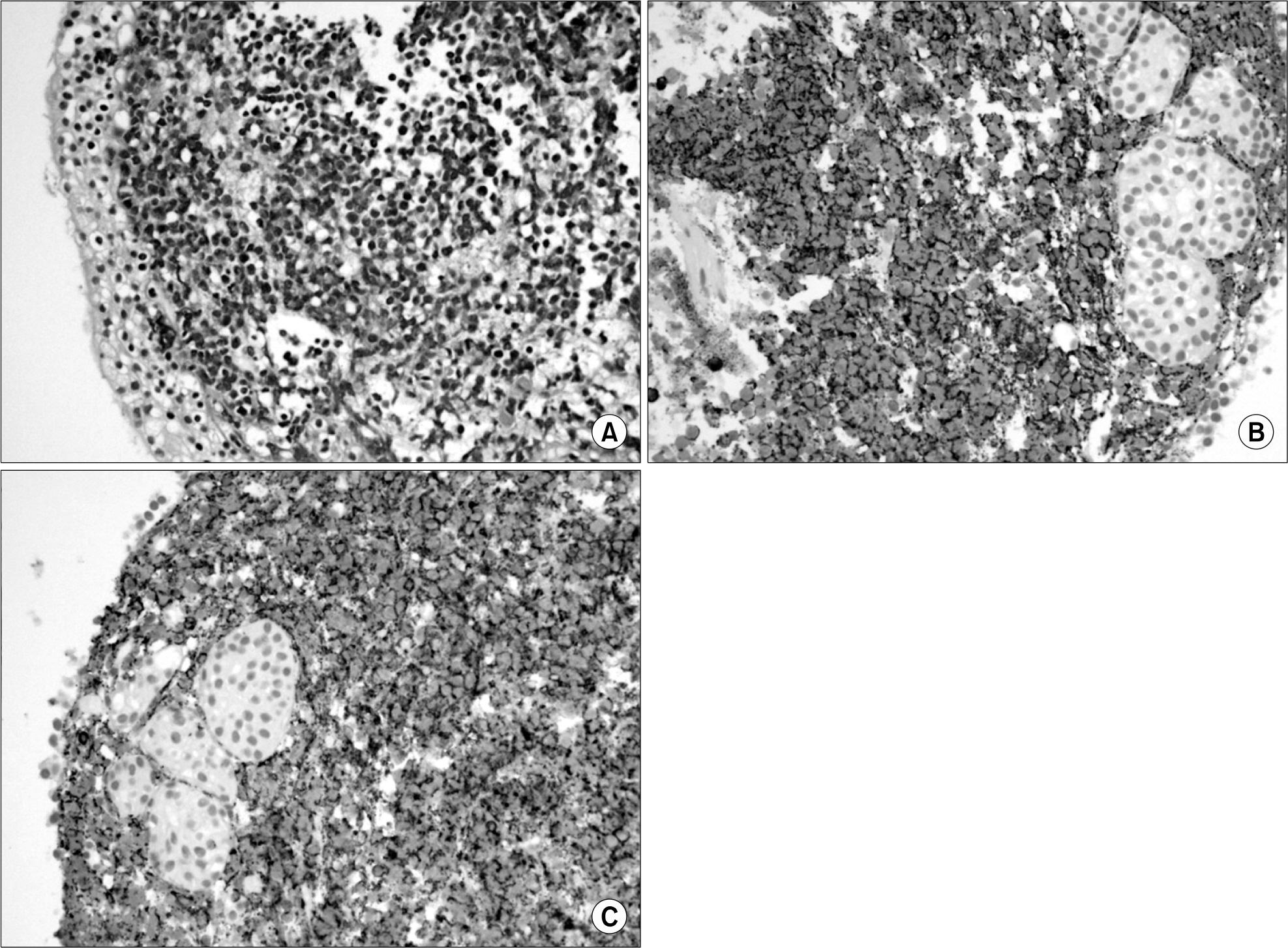Korean J Hematol.
2009 Jun;44(2):104-107. 10.5045/kjh.2009.44.2.104.
Primary Diffuse Large B Cell Lymphoma of the Bladder
- Affiliations
-
- 1Department of Internal Medicine, Pusan National University School of Medicine, Busan, Korea. porori701@hanmail.net
- KMID: 2252155
- DOI: http://doi.org/10.5045/kjh.2009.44.2.104
Abstract
- Primary malignant lymphoma of the urinary bladder is a rare disease, and it accounts for only 0.2% of all the cases of extranodal lymphoma. The prognosis of primary bladder lymphoma has been favorable, with many patients being alive and well several years after treatment. We report here on a case of primary diffuse large B cell lymphoma of the urinary bladder in a 75-year-old man patient who presented with a one-month history of persistent dysuria. The abdominal CT revealed a mass at the posterior wall of the urinary bladder. The tissue obtained by transurethral cystoscopy showed an atypical lymphoid proliferation, which was consistent with diffuse large B cell lymphoma. The patient received systemic chemotherapy of rituximab and CHOP (cyclophosphamide, doxorubicin, vincristine and prednisolone) and he achieved a significant partial remission.
MeSH Terms
Figure
Reference
-
References
1. Bang SM, Hahn JS, Lee JE, Kim GE, Yang WI. Primary lymphoma of genitourinary tract. Korean J Med. 2003; 64:567–75.2. Robert N, Jacques F, Valerie B, Susan S. The epidemiology of non-hodgkin's lymphoma: comparison of nodal and extranodal sites. Int J Cancer. 1997; 72:923–30.3. Hahn JS, Ko YW, Min YH, et al. Statistical analysis of malignant lymphoma in Korea. Korean J Hematol. 1995; 30:197–214.4. Freeman C, Berg JW, Cutler SJ. Occurence and prognosis of extranodal lymphomas. Cancer. 1972; 29:252–60.5. Ryan G, Martinelli G, Kuper M, et al. Primary diffuse large B-cell lymphoma of the breast: prognostic factors and outcomes of a study by the international extranodal lymphoma study group. Ann Oncol. 2008; 19:233–41.
Article6. Zucca E, Rogero E, Bertoni F, Cavalli F. Primary extranodal non-Hodgkin's lymphomas. Part 1: gastrointestinal, cutaneous and genitourinary lymphomas. Ann Oncol. 1997; 8:727–37.
Article7. Lee JY, Kim WS, Song SY, et al. A case of MALT lymphoma of the urinary bladder. Korean J Med. 2002; 63:98–102.8. Masahiko O, Katsuyuki A, Keisuke H, Akihisa K. Malignant lymphoma of bladder. Cancer. 1993; 72:1969–74.9. Hughes M, Morrison A, Jackson R. Primary bladder lymphoma: management and outcome of 12 patients with a review of the literature. Leuk Lymphoma. 2005; 46:873–7.
Article
- Full Text Links
- Actions
-
Cited
- CITED
-
- Close
- Share
- Similar articles
-
- Relapse of Ocular Lymphoma following Primary Testicular Diffuse Large B-cell Lymphoma
- A Case of Primary Cutaneous Diffuse Large B-cell Lymphoma
- A Case of Primary Rectal Diffuse Large B Cell LymphomaPresented as Multiple Polypoid Lesions
- A Case of Primary Cutaneous Diffuse Large B-cell Lymphoma
- Primary Cutaneous T-cell/histiocyte-rich B-cell Lymphoma



